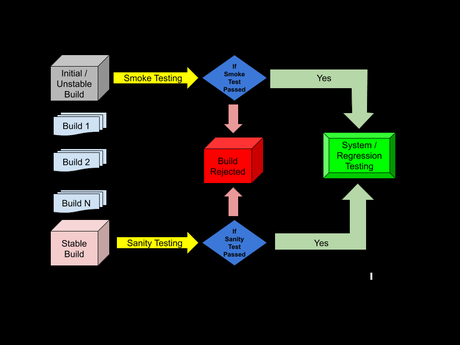Introduction
Smoke, Sanity & Regression testing are the basic testing concepts, which most QA teams/projects follow in different stages of software development. Anyone new to the QA process needs to know the basics of Smoke, Sanity & Regression testing for efficient and good Quality Assurance results.
Let’s discuss more about the importance & usage of these testing concepts below.
Refer to articles in the link here to know more about Manual Testing.
Software Build
Software Build is a process of converting source code, into a user application, after multiple revisions and code changes and Software Build creation involves multiple processes like, “Version Control, Code Quality & Compilation” and software build is also the result of this building process.
In this article, a build will be referred to as a testable version of the software.
Smoke Testing
Smoke testing is an approach which is usually carried out during the initial development stages of the Software Development Life Cycle(SDLC) to make sure that the core functionalities of a program are working fine without any issues. It is executed before any detailed functional tests are done on the software. The main intent of smoke testing is not to perform deep testing but to verify that the core or main functionalities of the program or the software are working fine. Smoke testing aims to reject a badly broken build in the initial stage so that the testing team does not waste time in installing & testing the software application.
Smoke testing is also called as Build Verification Test.
Let’s see a simple example where you are given an email application to test. The important functions would be logging in to the email application, composing an email and sending it, right? And, in case the email is not sent, does it make any sense to test other functionalities like drafts, deleted messages, archives, etc? This means you will have to drop the build without further validation. This is called Smoke testing.
The main focus of smoke testing is to test the critical areas and not the complete application.
When to perform Smoke Testing
- When developers provide a fresh build to the QA team. A fresh build here means when the build has new changes made by the developers.
- When a new module is added to the existing functionality.
Sanity Testing
Sanity testing is a kind of testing performed to check whether a software product is working correctly when a new module or functionality gets implemented to an existing product. Sanity testing is a software testing technique which does a quick evaluation of the quality of the software release to determine whether it is eligible for further rounds of testing or not.
Sanity testing is usually performed after receiving a fairly stable software build or sometimes when a software build might have undergone minor changes in the code or functionality. It decides if end to end testing of a software product shall be carried out further or not.

Why perform Sanity Testing
- To verify and validate the conformity of newly added functionalities and features in existing code.
- To ensure that the introduced changes do not affect other existing functionalities of the product.
- To decide further testing can be carried forward or not.
When to perform Sanity Testing
- Build is received after many regressions or if there is a minor change in the code.
- The build is received after bug fixing.
- Just before the deployment on production.
Regression Testing
Regression testing is the verification of “bug fixes or any changes in the requirement” and making sure they are not affecting other functionalities of the application. Regression testing is usually performed after some modifications have been made in the software build after requirement changes or bug fixes.
Once Sanity testing of the changed functionality is completed, all the impacted features of the application require complete testing. This is called regression testing.
Whenever bug fixes are done in the existing software, some test scenarios need to be executed, to verify the bug fixes. In addition to these, the QA team also has to check the impacted areas, based on the code changes. In regression testing, all those test scenarios will have to be executed, to take care of related functionalities.
When to perform Regression Testing
- After Code modification according to the required changes
- After some new features are added to the application
- After some bug fixes are incorporated into the build
Differences Between Smoke vs Sanity vs Regression Testing
Smoke Testing Sanity Testing Regression Testing
Performed on initial builds Performed on stable builds Performed on stable builds
To test the stability of new build To test the stability of new functionality or code changes in the existing build To test the functionality of all affected areas after new functionality/code changes in the existing build
Covers end to end basic functionalities Covers certain modules, in which code changes have been made Covers detailed testing targeting all the affected areas after new functionalities are added
Executed by testers & sometimes also by developers Executed by testers Executed by testers, mostly via automation
A part of basic testing A part of regression testing Regression Testing is a super set of Smoke and Sanity Testing
Done usually every time there is a new build Planned when there is not enough time for in-depth testing Usually performed, when testers have enough time
Key Points
- Smoke and Sanity testing help the QA team save time by quickly testing to make sure if an application is working properly or not. Also, it ensures that the product is eligible for further testing. Whereas Regression testing helps enhance the confidence about the software quality after a particular change. Especially, that the code changes are not affecting related areas.
- Smoke Testing is done by both the dev team or by the QA team and can be taken as a subset of rigorous testing. Whereas both Sanity & Regression testing are done only by the QA team. Also, Sanity testing can be considered as a subset of acceptance testing.
- Smoke testing is executed at the initial stage of SDLC, to check the core functionalities of an application. Whereas Sanity & Regression testing are done at the final stage of SDLC, to check the main functionalities of an application.
- As per the requirement of testing & time availability, the QA team may have to execute Sanity, Smoke & Regression tests on their software build. In such cases, Smoke tests are executed first, followed by Sanity Testing & then based on time availability regression testing is planned.

